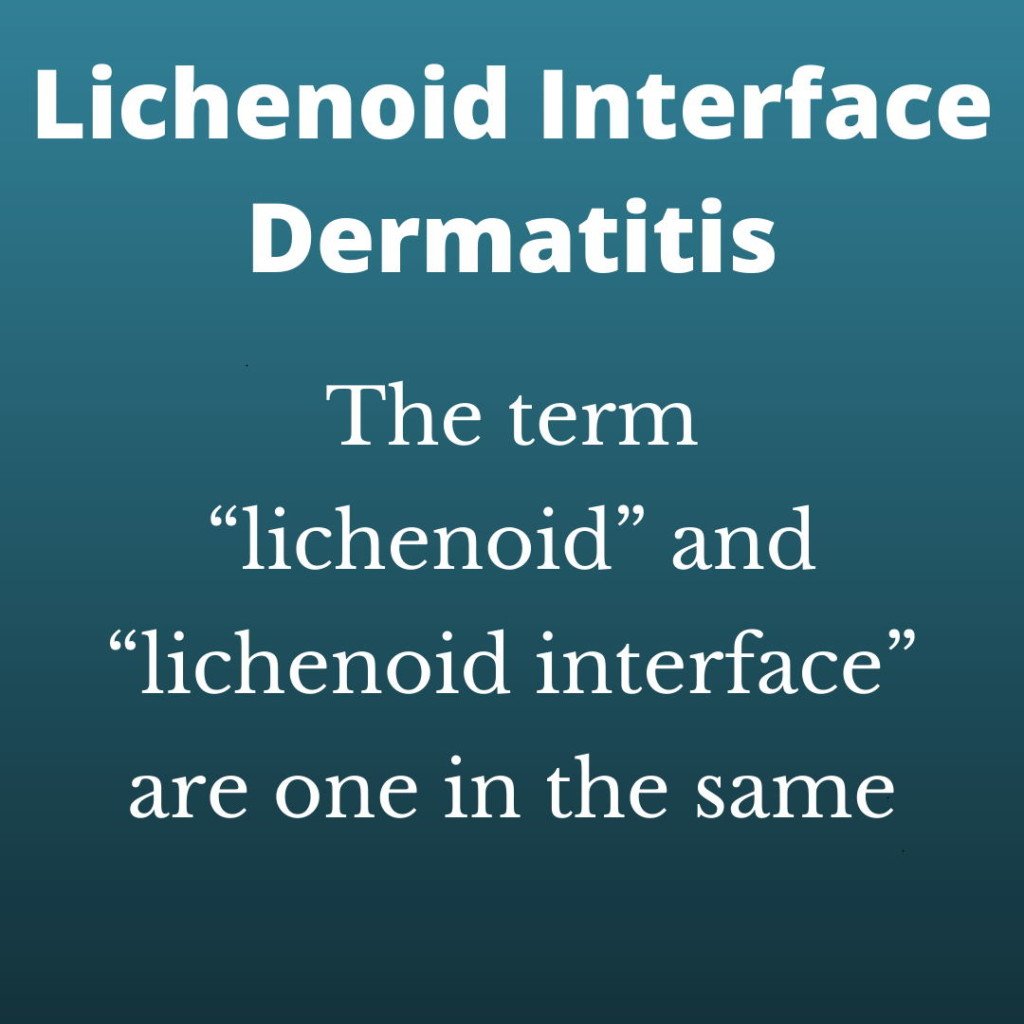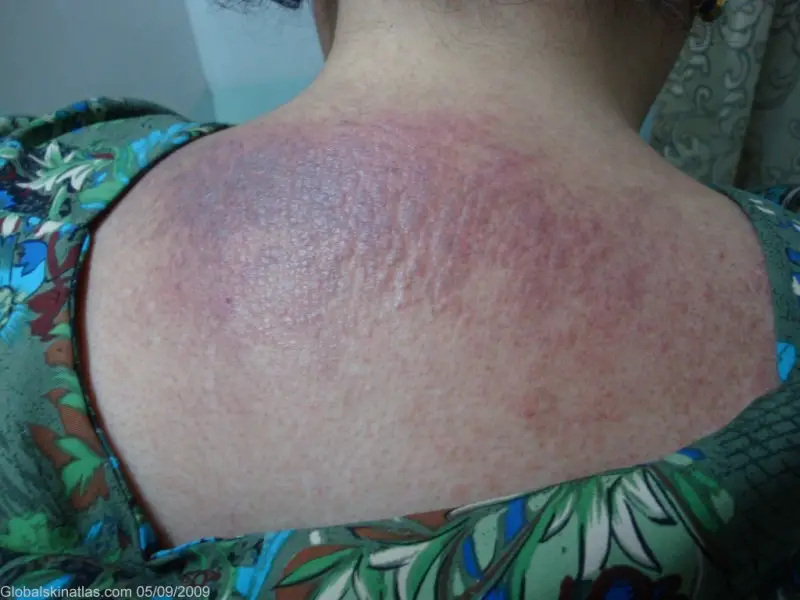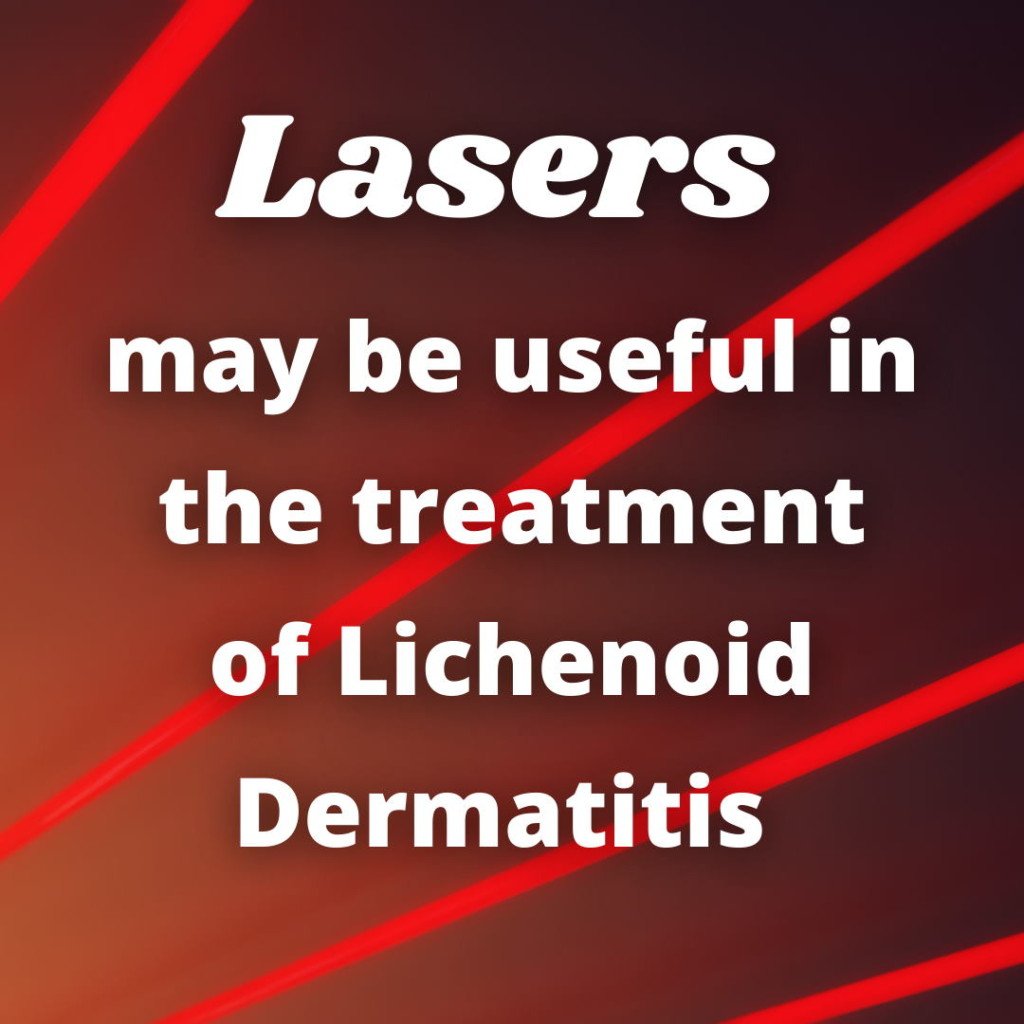Lichenoid dermatitis is a type of chronic inflammation of the skin. It occurs when the immune system overreacts to a trigger, such as an allergen or an irritant. This overreaction causes the skin to become red, flaky, and crusty. This may be your first time hearing about this condition, which can be scary if you or a loved one has been diagnosed. If you are looking to get the most up-to-date information including causes, symptoms, treatments, and overall education, you are in the right place!

Table of Contents
What is Linchenoid Dermatitis?
Lichenoid Dermatitis is a skin condition that looks like “lichen”. Merriam-Webster’s medical definition is “any of several skin diseases characterized by the eruption of flat papules: especially Lichen Planus.
When we break down the words “lichen” and “dermatitis”, we get this.
Lichenoid: Broad term for skin diseases that have a flat bump (papule).
Dermatitis: Inflammation of the skin
Combine these words and we get something like “Inflamed skin bumps” This of course is a very basic meaning of the condition, but this condition can be complex.
What does Lichenoid Dermatitis Look like?

Lichenoid dermatitis can look different from person to person. Typically, this form of eczema will show up as red-raised bumps on the skin.
The best way to describe what Lichenoid Dermatitis looks like is with pictures. For the largest collection of images, check out 30 Pictures of Lichenoid Dermatitis.
Lichenoid Interface Dermatitis

According to The National Library of Medicine, Lichenoid interface dermatitis is really the same term as just lichenoid dermatitis. The term “interface” refers to the inflammation between the epidermis and dermis layers of the skin. Overall, lichenoid dermatitis and lichenoid interface dermatitis are broad terms for inflammatory skin conditions.
Causes of Lichenoid Dermatitis
There are many possible causes of lichenoid dermatitis. The most common triggers are allergies and contact with irritants. Allergies can be triggered by anything from cosmetics to food. Contact with irritants can occur when the skin comes into contact with harsh chemicals, detergents, or other substances. In some cases, this form of dermatitis may be caused by an underlying medical condition.
Contact Dermatitis

Contact dermatitis is a skin problem that happens when you touch something that makes your skin itchy and red. It’s also called skin irritant contact dermatitis. Contact dermatitis is common and usually not serious. But it can be very uncomfortable, so you’ll want to get rid of it as soon as possible.
Contact Dermatitis Triggers
Allergic contact dermatitis can develop from exposure to a wide range of triggers, here are the most common:
- Adhesives: The adhesives used in bandages, tapes, and even certain medical devices can cause allergic contact dermatitis.
- Cleaning products: Certain ingredients in household cleaning products, such as detergents and solvents, can lead to skin allergies.
- Cosmetics: Various ingredients in makeup, including dyes, preservatives, and fragrances, can trigger allergic contact dermatitis.
- Fabrics: Some people may develop allergic reactions to certain synthetic materials, like nylon or polyester, or even specific dyes used in fabrics.
- Fragrances: Perfumes, colognes, scented lotions, and other cosmetic products containing fragrances can trigger allergic reactions.
- Hair dyes: Chemicals like para-phenylenediamine (PPD) and ammonium persulfate found in hair dyes can cause allergic reactions in some people.
- Industrial chemicals: Occupational exposure to chemicals like solvents, oils, and cleaning agents can trigger allergic contact dermatitis in workers.
- Latex: Latex gloves, condoms, and other products made from natural rubber latex can lead to skin allergies.
- Medications: Certain topical medications, such as antibiotic creams, can cause allergic contact dermatitis in some individuals.
- Metals: Nickel, cobalt, and chromium are common metals found in jewelry, belt buckles, and watches that can cause skin allergies.
- Plants: Poison ivy, poison oak, and poison sumac contain a substance called urushiol, which can cause allergic reactions upon contact with the skin.
- Preservatives: Preservatives like formaldehyde, parabens, and methylisothiazolinone (MI) found in personal care products, such as shampoos, soaps, and moisturizers, can cause allergic contact dermatitis.
It’s important to note that individual sensitivities can vary, so it’s best to consult with a healthcare professional for an accurate diagnosis and management of allergic contact dermatitis.
Sun Exposure

Tropical lichen is believed to be caused by sunlight, or damage to the skin from ultraviolet (UV) rays. a German study found that lichen lesions were observed in up to 30% of their tropical/subtropical study population.
Lichenoid Drug Eruption

Lichenoid Drug Eruption (LDE), or Drug-Induced Lichenoid Dermatitis is a reaction caused by ingested or injected drugs/medications.
Medications that May Cause Lichenoid Drug Eruptions (LDE)
According to the Indian Journal of Dermatology, these drugs can cause lichenoid eruptions or lichenoid dermatitis:
- Amlodipine
- ACE inhibitors (captopril, enalapril)
- Beta-blockers (propranolol, oxprenolol, labetalol)
- Cyanamide
- Gold salt
- Interferon alpha-2b intravenous globulil
- Levamisole
- Methyldopa
- Non-steroidal anti-inflammatory drugs(NSAID)
- Omeprazole / lansoprazole / pantoprazole
- Penicillamine
- Streptomycin
- Simvastatin
- Suramin
- Tiopronin
Infections

Infections can cause lichenoid dermatitis through various mechanisms. Certain microorganisms, such as bacteria or viruses, directly infect the skin or mucous membranes and cause an inflammatory response. This inflammatory response can lead to the characteristic lichenoid appearance of the skin.
Autoimmune Disorders
Certain autoimmune disorders are known to be associated with lichenoid dermatitis. For example, some individuals with autoimmune diseases like lupus or autoimmune hepatitis may develop lichenoid dermatitis as a manifestation of their underlying autoimmune condition.
Can Lichenoid Dermatitis Be Cured?

Possibly. Lichenoid dermatitis refers to a group of inflammatory skin conditions characterized by the presence of lichenoid tissue reactions. These reactions occur when certain cells in the skin’s immune system react in response to various triggers.
Determining what is causing your symptoms would be the first step in knowing if there is a cure. For example, If your lichenoid dermatitis is caused by a certain medication, then in theory, switching medications could “cure” your symptoms.
Lichenoid Dermatitis Symptoms

The most common symptom of lichenoid dermatitis is itchiness. The rash may also be accompanied by burning, stinging, or pain. The rash typically appears as small, red, or purple bumps on the skin, and can appear anywhere on the body. In severe cases, the bumps may blister or bleed. Here are the most common symptoms:
- Dermatosis (skin defect or lesion on the skin)
- Inflamed skin with papules (can appear anywhere on the skin)
- Itchiness
- Lesions
- Rash
- Red or purple bumps
- Thickening of skin
Disorders Linked to Linchenoid Dermatitis
Lichenoid dermatitis is essentially a blanket term for a variety of disorders. According to the book, What is Lichenoid Dermatitis? By Diya F. Mutasim, this term is a combination of disorders related to lichen planus (LP), such as:
- Keratosis Luchenoides Chronica
- Lichen Nitidus
- Lichenoid Capillaritis (Lichen Aureus)
- Lichenoid Drug Eruption (LDE)
- Lichenoid Keratosis
- Lichenoid Mycosis Fungoides
- Pityriasis Luchenoides
Keep in mind, that this is not a complete list of disorders that can be linked to this condition. Talk with your doctor for more information.
Lichenoid Dermatitis Treatment Options
There is no cure for lichenoid dermatitis. However, there are treatments that can help to control the symptoms and prevent flare-ups. Avoiding triggers is the best way to prevent flare-ups. If you know what triggers your rash, it is important to avoid them as much as possible. If you cannot avoid triggers completely, you may need to take medication to help control your symptoms. Steroids and antihistamines are commonly used to treat this form of dermatitis. In severe cases, phototherapy may be recommended.
Investigate Your Current Medications

Some medications have side effects that cause Lichenoid Drug Eruptions (LDE). Investigate your medication’s side effects and see if LDE is on the list. If so, talk with your doctor and see if there is a medication you could use instead.
Antihistamines

The use of antihistamines may assist with taking away any itching that you have developed. Histamines are released when you have an allergic reaction, and they cause swelling, itching, and redness. Antihistamines work by blocking the action of histamines. You can find antihistamines at your local drugstore, or online.
Topical or Oral Steroids

Topical corticosteroids are the most common treatment option for Lichenoid Dermatitis. These creams are anti-inflammatory medications that are applied directly to the skin and are available with a prescription or over the counter.
The American Journal of Dermatopathology posted a study that documented the use of topical steroids or oral systemic treatments in patients with lichenoid dermatitis. The study concluded that these treatments were acceptable and responsive.
Immunosuppressants
Immunosuppressants help dermatitis by stopping the body from attacking the skin. This type of medication is typically prescribed when other treatments, such as corticosteroids, haven’t worked. Some common immunosuppressants that may be used to treat dermatitis include:
- Azathioprine
- Cyclosporine
- Methotrexate
These medications can cause serious side effects, so they’re usually only used when other treatments haven’t worked. If you take immunosuppressants, you’ll need to be closely monitored by your doctor.
Lasers (Phototherapy)

Lasers are still being studied on how they actually treat this form of dermatitis, but they seem to be working. This case study explains that a patient who was on a 10-month regimen of corticosteroids, received 6 laser treatments and the lesions were gone.
Astonishingly, she followed up 4.5 years later, and still, no lesions or scars were observed.
There are two types of phototherapy: UVB and PUVA. UVB light is used to treat conditions like eczema and psoriasis. PUVA light is used to treat conditions like vitiligo, which is when the skin loses its color.
Phototherapy can be done in a doctor’s office or at home. People who get phototherapy will usually see their skin start to improve within a few weeks.
If you are thinking about getting phototherapy, talk to your doctor first. They can tell you if it is right for you.
FAQs
Here are the most frequently asked questions about lichenoid dermatitis.
Is Lichenoid Dermatitis Contagious?
No, lichenoid dermatitis is not contagious and cannot be spread from person to person. This condition is inflammation of your own skin, and you do not transfer this inflammation to others.
Does Lichenoid Dermatitis Go Away?
Maybe. This condition is the catch-all for the symptoms you are having on your skin. The real culprit will need to be discovered and treated appropriately.
For instance, in cases where the cause of the condition is known (i.e. drug-induced or contact dermatitis) yes, the symptoms can go away.
Is Lichenoid Dermatitis Dangerous?
Maybe. Lichenoid dermatitis is inflammation of the skin, which is not usually considered dangerous. But, there are non-serious and serious conditions that can cause lichenoid dermatitis, so it is always best to get evaluated by a medical professional.
Final Thoughts
That was a lot of information on lichenoid dermatitis. What has been your experience with this condition so far? Send me an email if you’d like to share! Email: chris@allergypreventions.com
